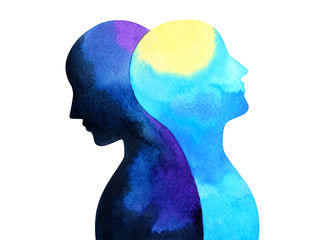Bipolar Disorder
Bipolar Disorder
A Diagnostic Chameleon
Posted August 14, 2019 Reviewed by Gary Drevitch

Bipolar disorder is a relatively common affliction that affects as many as 2.6 percent of the U.S. population, if not more. It is also within the top 20 leading causes of disability globally and leads to a higher rate of hospitalization, suicide attempts, and completed suicides than major depressive disorder. Despite its prevalence, bipolar disorder is difficult to diagnose and misdiagnosis is extremely common. In fact, the mean delay between its onset and correct diagnosis falls between six and 10 years.
The inability to properly diagnose bipolar disorder is largely due to its similarity to unipolar depressive disorder, a condition also known as clinical depression or major depressive disorder. A study that arose from the initiative Bipolar Disorders: Improving Diagnosis, Guidance, and Education (BRIDGE) found that, of the 5,635 participating adults who were believed to have major depressive disorder, 903 fulfilled the criteria for bipolar disorder. In other words, 16.1 percent of those involved in the study had been misdiagnosed and were being treated for the wrong condition.
What is Bipolar Disorder?
“Bipolar disorder” is an umbrella term used to describe a cluster of afflictions with a similar symptomatology. They also all possess a strong genetic component. Within this group of conditions, one finds bipolar I disorder, bipolar II disorder, cyclothymic disorder, and less common forms of the disorder, some which can be induced by substances or medical conditions.
Patients who have one of these conditions tend to alternately experience episodes of depression and episodes of mania or hypomania, which is less severe and/or protracted than an episode of mania. Depressive states are characterized by low mood, lethargy, apathy, and anhedonia (loss of feelings of pleasure). Manic states are characterized by feelings of elation, increased energy, and reduced need for sleep. Additionally, individuals in the throes of mania oftentimes have an inflated sense of self-esteem, engage in reckless acts (such as rash investments, impulsive shopping sprees, excessive substance use, or risky sexual behavior), begin numerous complex projects simultaneously, and can feel as though their thoughts are racing at such a frenzied pace that it can be difficult to speak in an organized fashion.
According to DSM-5, individuals with bipolar I disorder experience at least one manic episode that lasts at least one week and is present most of the day for nearly every day within this period of time. These episodes are frequently bookended by periods of hypomania or depression, but neither hypomania nor a major depressive episode is necessary for a diagnosis of bipolar I disorder.
The DSM-5 states that individuals with bipolar II disorder experience at least one major depressive episode in their lifetime that persists for at least two weeks, as well as at least one hypomanic episode lasting four days in which symptoms are present most of the day for nearly every day. If the episode is determined to be manic, rather than hypomanic, the diagnosis is bipolar I disorder.
Cyclothymic disorder is typically less severe than either bipolar I or bipolar II disorder and is characterized by alternating periods of elevated and depressed mood. However, at no point does the elevated mood become mania or hypomania. Similarly, at no point does the depression qualify as a major depressive episode.
Telling Bipolar Disorder from Major Depressive Disorder
Distinguishing a depressive bipolar episode from major depressive disorder poses several diagnostic challenges, as the symptoms are almost identical. One study even found that only 20 percent of bipolar patients in the midst of a depressive episode were correctly diagnosed within their first year of seeking treatment.
Misdiagnosis is particularly common when the onset of bipolar disorder begins with a depressive episode. Though the patient may eventually experience either manic or hypomanic episodes, this is not apparent to medical professionals when they make their initial diagnosis. Consequently, they lack the necessary context to recognize that the patient has bipolar disorder and not major depressive disorder.
Yet another reason for frequent misdiagnosis is that patients with bipolar I disorder and bipolar II disorder tend to experience mania or hypomania infrequently when compared to depression, and, consequently, are far more likely to seek the help of a medical professional while in a depressive state. One study found that patients with bipolar I disorder were symptomatic during 47.3 percent of weeks, and that 68 percent of symptomatic weeks were characterized by depressive symptoms, 19 percent of symptomatic weeks were characterized by manic or hypomanic states, and 13 percent of symptomatic weeks were characterized by cycling or mixed symptoms. Another study found that patients with bipolar II disorder experience symptoms more often (55.8 percent of weeks) with an even greater prevalence of depression and a significantly lower frequency of either hypomanic or cycling/mixed states. During symptomatic weeks, patients experienced depression 93 percent of the time, hypomania 2.5 percent of the time, and mixed/cycling symptoms 4.5 percent of the time.
This tendency to seek help while experiencing a depressive episode may also be the result of a more willful reporting bias. On the one hand, many patients may not report the experience of manic episodes that are either short-lived or lack severely reckless behavior, largely because they do not recognize these states as being part of a larger illness. Patients may not even know that they are experiencing hypomania or the kind of subthreshold hypomania characterized by cyclothymic disorder. This is especially the case with creative or artistic patients. They may be under the impression that the “creative juices” are merely flowing more readily than normal or that their lack of sleep and increased energy are due to their excitement about a project or series of projects.
In other cases, patients may perceive manic episodes as a positive experience and may not want to give them up. They feel on top of the world, full of energy, and ready to take on any task. Unfortunately, such a boost in self-confidence oftentimes leads to incredibly dangerous behavior. Manic patients may inadvertently drain their bank accounts, irrevocably destroy relationships, and run afoul of the law.
Why Misdiagnosis Is Dangerous
Misdiagnoses can be dangerous for several reasons. Perhaps most obviously, accurate diagnoses allow medical professionals to better treat the underlying condition, no matter what it may be. This is as true for mental illnesses like bipolar disorder as it is for any other kind of condition.
Even if some symptoms of bipolar disorder overlap with other mental illnesses, most notably clinical depression, the two are not the same and should not be treated as such. Of equal importance is the fact that effective treatment options for bipolar disorder vary from those for other conditions, and prescribing pharmaceuticals meant to treat another affective disorder may exacerbate some symptoms of bipolar disorder and cause more serious manic or depressive episodes.
As mentioned in a previous post, there have been advances in using biomarkers to diagnose bipolar disorder and, one day, medical professionals may be able to regularly rely on objective means of testing for numerous mental illnesses, not only bipolar disorder. However, at this time, the most widely practiced method of diagnosing bipolar disorder continues to be the observation of observable signs and the self-reporting of symptoms from patients.
To ensure that patients receive a correct diagnosis of bipolar disorder, it is crucial that they share any family history of the illness when being examined by a medical professional and report any symptoms of hypomania or mania, not only depressive episodes. By sharing this information, they can prevent any long-term deleterious effects of misdiagnosis.
Furthermore, patients who know they have bipolar disorder or believe that they may potentially develop the condition due to family history or genetic predisposition should have an open line of communication with a mental health professional whom they trust and who is attentive to even minor changes in symptoms, as sudden modifications to treatment are often necessary to ensure effective treatment.
Dr. Ahmad reports no conflict of interest. He is not a speaker, advisor, or consultant and has no financial or commercial relationship with any biopharmaceutical entity whose product/device may have been mentioned in this article.




